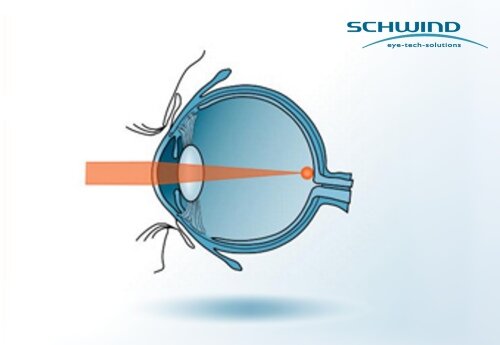Visual defects and correction
Vision sometimes needs a little help
The human eye is an impressive system for turning light rays into images. The light reflected by objects in the field of view first hits the cornea, which is protected by a clear tissue covering called the epithelium. The cornea is responsible for about 70% of the refraction or focusing of the light.
The light then passes through the pupil, i.e. the central opening in the iris, and reaches the lens. The lens does the final focus adjustment so that the light is bundled, i.e. focused, when it reaches the retina. At the retina, the light is translated into electrical impulses and sent to the optic nerve. The optic nerve takes these impulses to the brain, which translates them into images.
If all goes well, the cornea and lens bundle the light rays exactly on the retina. This is what we call “normal vision.” Everything is in sharp focus at all distances.
Visual acuity
Visual ability is referred to as visual acuity in medical circles. “Normal” vision corresponds to an acuity of 1.0 (commonly called 20/20 in the US or 6/6 in metric countries). A person with this acuity can make out a 1.5 mm object at five metres distance. A person who cannot see objects smaller than 3 mm at this distance has an acuity of 0.5 (20/40 or 6/12). Many people have better than normal vision; young people quite often have visual acuity between 1.0 and 2.0 (20/20 – 20/10 or 6/6 – 6/3). This declines with age and can become substantially worse than 1.0.
Many people could have better vision but are not aware of it. What we consider “normal” vision is not in fact all that normal, since 48 percent of people in Europe wear glasses, not counting contact lenses and not counting people with undiagnosed or untreated visual defects. The vast majority of these defects are due to a mismatch between corneal shape and eye length. These are called “refractive errors,” i.e. problems in the refraction of the light by the cornea, so that the light is not focused on the retina.
In laser treatment, for example with the sophisticated SCHWIND AMARIS laser systems, the shape of the cornea is modified to enable full visual acuity without glasses or contact lenses.
Nearsightedness
Myopia is often called nearsightedness, because people who have it can only see nearby objects in sharp focus. It is caused by too much curvature of the cornea relative to the length of the eyeball. This causes the light rays in the eye to be focused in front of the retina instead of on it.
In laser correction, this curvature is reduced, moving the focal point of the light to the retina and enabling clear vision without corrective lenses.
Farsightedness
Hyperopia, or farsightedness, is just the opposite – people with it can see clearly far away, but not close up. It is caused by insufficient curvature of the cornea relative to the length of the eyeball. This puts the focal point of the light rays behind the retina instead of on it.
In laser correction, the curvature of the cornea is increased, moving the focal point of the light to the retina and enabling clear vision.
Presbyopia
Presbyopia is an age-related condition that occurs as the lens loses its ability to change shape. This reduces the eye’s ability to adjust for different distances, especially close up, so that the weakly bundled light rays are not focused at the retina.
In “PresbyMAX” treatment with SCHWIND AMARIS, close-in clarity becomes easy again for people with aging eyes. The treatment can also alleviate other vision defects like nearsightedness, farsightedness or astigmatism.
Astigmatism
In astigmatism, the cornea is misshapen and does not properly focus the light entering the eye. Instead of hitting the retina in a focused point, the light is spread over two or more points. The result is a blurry or stretched image.
In laser treatment, the cornea is brought into a shape that focuses the light on the retina correctly.
Higher-order defects (aberrations)
Higher-order vision defects, often called aberrations, can take many different forms. Aberration is a synonym for error and refers to the fact that in higher-order defects the light rays are focused erroneously so that they don’t form a clear picture. 80% of aberrations are caused by corneal defects, and only 20% by issues with the lens or vitreous body. On most people these errors are so small that they don’t impair visual acuity. Higher-order defects become most noticeable at night and in twilight, when light reaches the retina with less focus. Under these conditions, vision can become much worse and/or the individual is more susceptible to glare.
These visual defects can often be corrected by laser surgery with wavefront-guided treatment. This requires that the aberrations be precisely localised. SCHWIND offers diagnostic systems that deliver extremely precise information on the cornea and the entire eye, enabling individually adapted treatment.
Touch-free and gentler to the eye: SCHWIND SmartSurfACE
The SCHWIND AMARIS family works with all common treatment methods. This includes SCHWIND’s innovative SmartSurfACE technology. SmartSurfACE combines the benefits of touch-free TransPRK surface treatment with innovative SCHWIND SmartPulse technology. In TransPRK, vision is precisely corrected through the top layers of the cornea, gently and without touching the eye.
It works without suction, cut or incision. SmartPulse leaves the cornea surface smoother after lasering, accelerating the healing process. The patient experiences more comfortable treatment and faster recovery.













